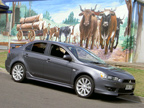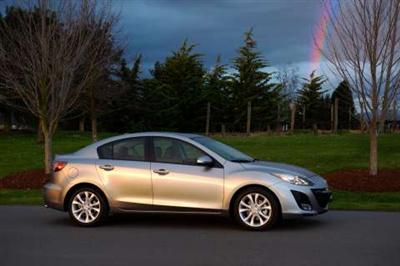|
| ||||||||||||||||||||||||||||||||||||||||||||||||||||||||||||||||||||||||||||||||||||||||||||||||||||||||||||||||||||||||
|
2009 Mazda 3 Sedan Revealed
23rd November, 2008 | |||||||||||||||||||||||||||||||||||||||||||||||||||||||||||||||||||||||||||||||||||||||||||||||||||||||||||||||||||||||
|
The popular Mazda 3 – the company’s best-selling vehicle worldwide – arrives as a fully re-engineered, redesigned second generation small sedan providing:
This new generation Mazda 3 continues Mazda's small car heritage. Meanwhile, the first generation Mazda 3 achieved 1.8-million sales during its five years serving customers all over the world. In fact, one in three Mazdas sold is a Mazda 3. Mazda 3 Programme Manager Yoshiyuki Maeda established ambitious goals for Mazda’s most popular car line: “We were determined to advance the Zoom-Zoom driving experience to new heights because that unique feeling lies at the very heart of Mazda. On the 'heels' of the original Mazda 3’s success, we aimed to again exceed the expectations of customers all over the world by a wide margin. This meant providing drivers with a sense of exhilaration whether they were in motion, seated in the Mazda 3’s cockpit, or enjoying its appearance from outside.” On what it takes to develop a true “world car”, Maeda added; “the development process began with careful study and identification of the features and performance qualities that would be needed. That initial phase ended with the conclusion that every driving characteristic was eligible for improvement to reach our Zoom-Zoom goals. Mazda engineering and R&D departments in Japan, Europe, and the US all contributed to the Mazda 3’s renewal effort and the development of the company’s new world car.” EXTERIOR DESIGNRecognisable as a Mazda 3 with more expressive and dynamic features Chief designer Kunihiko Kurisu’s mission was to remain faithful to the Mazda 3’s existing visual identity while evolving its appearance with richer, bolder design strokes. Infusing each new model with more emotional aesthetics is now a Mazda tradition. The key Mazda 3 exterior design highlights are:
INTERIOR DESIGN High quality, sophisticated and sporty Inside, the new generation Mazda 3 offers a sporty, refined cabin. The dash sweeps tautly and dramatically from its centre to the cabin’s sidewalls. The large gauge cluster and centre stack are positioned to tightly link the driver to the car’s instruments and controls. The slant of the instrument panel optimises operating efficiency while providing an attractive focal point. Range of motion studies helped position all controls at an ideal reach. Key knobs and switches are positioned at the same level as the steering wheel and the shifter. The interior of the new generation Mazda 3 is based on our Human Machine Interface concept. All the information a driver needs is readily available in one concentrated area that minimises lapses of concentration on the road ahead. A Multi-Information Display is positioned high on the centre of the instrument panel to further minimise distraction. Navigation, audio, and trip computer information is provided in this handy and easy-to-view location. Front seat cushions have been extended by more than 2 cm to provide improved thigh support. Backrests are 3.5 cm taller and re-contoured for improved driving posture. For the higher grade models, upper side bolsters have been canted inward for heightened torso restraint during aggressive cornering. To provide a top-quality cockpit appearance, the number of parting lines is minimised and soft-touch surfaces show a grained texture. An interactive lighting system enhances the cabin’s ambience and sense of tranquility. Upon entry, illumination rises in intensity in a programmed manner. Occupants are welcomed by foot-well and door-handle lamps. Next, instrument cluster, centre stack, audio and climate controls brighten. When a driver or front seat occupant touches an audio or A/C switch, a change in illumination acknowledges that the command has been received. Dual-zone automatic air-conditioning is an available Mazda 3 option. Other special features are: a Bose premium surround sound system with 10 speakers, connectivity for mobile phones and portable media players, a dock for iPods, and Sirius satellite radio. An advanced keyless entry system includes push-button engine starting. The options list includes rain-sensing wipers, heated side mirrors, leather upholstery and heated front seats. POWER TO GO Spirited powertrains engineered for Maximum Zoom-Zoom The MZR 2.0-litre four-in-line engine delivers 148 horsepower at 6,500 rpm and 135 lb-ft of torque at 4,500 rpm. Aluminium block and head construction saves weight. In the interests of power and efficiency, four valves per cylinder are operated by dual overhead camshafts. The new MZR 2.5-litre four-cylinder engine is borrowed from the larger 2009 Mazda 6. It shares the same construction features of the 2.0-litre engine while increasing output to 167 horsepower at 6,000 rpm and 168 lb-ft of torque at 4,000 rpm. Both engines employ advanced electronic throttle actuation. Mazda’s exclusive torque base control technology provides a highly linear acceleration response to every change of throttle pedal pressure. A slick-shifting five-speed and six-speed manual transmission as well as a five-speed electronically controlled Sport-AT automatic transmission are available depending on the model. Sport-AT offers enthusiastic drivers the control of manual gear engagement with the convenience and comfort of a conventional automatic. To refine the acoustic qualities of the Mazda 3 powertrains, extra attention was paid to tuning each engine’s intake and exhaust system. Resonance chambers were implemented to quiet certain sound frequencies while reinforcing others, achieving a well mannered yet sporty 'voice' during acceleration. The Mazda 3 2.5-litre engine is equipped with dual tailpipes and specially tuned mufflers to reduce mid-range boom and objectionable high frequency noise at high rpm. SOUND FOUNDATION Increased structural integrity and reduced aerodynamic drag contribute to new generation Mazda 3’s poise and performance The current generation Mazda 6 offers one of the stiffest unibody structures on any Mazda vehicle. Lessons learned in developing that car provided major strides in structural stiffness in the new Mazda 3. A stiff monocoque chassis provides a smoother ride, more confident handling, and improved agility with virtually no increase in unibody weight. Re-engineered monocoque joints and increased metal gauges in key areas help diminish the transmission of road and powertrain noise into the passenger cabin. Suspension anchor points are more substantial to provide the solid foundation needed to absorb steering and suspension forces. In addition to welded attachments, suspension towers are bonded to the surrounding unibody areas with structural adhesives. A combination of welding and adhesives – also borrowed from Mazda 6 – is also used to increase the rigidity and collision deformation resistance at door opening locations. The stiffer door design also improves the effectiveness of weather seals that block moisture and noise from the interior. A Mazda engineering approach called Aero Flow Management was used to optimise the flow of air around and through Mazda 3 body openings. Even though the front grille appears larger than before, it’s actually 20 per cent smaller to ingest only the amount of air needed for combustion and cooling. An air guide attached to the front bumper directs the flow through the radiator where it’s most useful. At high speeds, a bypass flap opens to minimise cooling fan drag. Air flow along the Mazda 3’s body sides was improved during wind tunnel testing by placing deflectors near the tyres and by carefully tuning the upper-forward corners of the cabin. Subtle refinements in the shape of the A-pillars, exterior mirrors, windshield wipers, and tail lamps also contributed to the six per cent reduction in wind noise levels. CLASS-LEADING CHASSIS DESIGN Subtle yet comprehensive refinements advance the compact class’s sportiest model to new heights of driving fun and function A rubber-isolated subframe in front supports the entire powertrain, the rack-and-pinion steering system, and the lower attachments of the coil spring MacPherson strut suspension. The independent multi-link rear suspension also uses coil springs with one trailing arm, two lateral links, and one toe-control link per side. Four-wheel power disc brakes with vented rotors in front and solid rotors in back are standard equipment. Dynamic Stability Control and Traction Control are available on some new Mazda 3 models. To improve steering feel, the electro-hydraulic-assist rack-and-pinion steering gear is now secured at three instead of two attachment locations. The additional mounting point allowed a reduction in the stiffness of the bushings that support the steering gear to diminish the vibration transmitted over rough pavement. Resistance to body roll has been increased by recalibrating the monotube rear dampers for tighter control and by switching to a new more substantial mounting arrangement for the front and rear anti-roll bars. At the front of the new Mazda 3, lower control arms, the subframe, and mount bushings are all stiffer to improve both steering response and cornering grip at the adhesion limit. A redesigned rear suspension crossmember is both lighter and significantly stiffer, also for improved handling. The most notable change to the braking system is a new vacuum booster that provides a more reassuring response to light pedal efforts without disturbing the highly direct and linear feel inherited from the first-generation Mazda 3. Adjustments to the electronic brake force distribution programming enhance vehicle stability during mixed braking and cornering manoeuvres. Structural changes to the unibody mentioned above help improve not only the rigidity of the brakes but also their linearity during high-g stops. The Mazda 3 with 2.0-litre engine is equipped with 10.9-inch diameter front rotors and 10.4-inch diameter rear rotors while the more powerful 2.5-litre Mazda 3 is fitted with 11.8-inch front and 11.0-inch rear rotors. ACTIVE AND PASSIVE SAFETY SYSTEMS The new Mazda 3 is meant to be fun to drive; its high level of manoeuvrability is also a hedge against a collision Providing the Mazda 3 driver with a better ability to avoid a collision by steering or braking safely out of harm’s way is a fundamental aspect of Mazda’s product development. Mazda’s engineers strongly believe that the best way to help protect occupants in a crash is to engineer control systems in such a way that the crash is avoided in the first place. Carefully tuned electro-hydraulic power steering, a highly agile suspension system, and powerful disc brakes are standard Mazda 3 features. Whilst not available as standard, ABS, Dynamic Stability Control, and traction control are offered as optional equipment. Also, a new Adaptive Front Lighting System with self-levelling Bi-Xenon headlamps has been added as standard on Grand Touring models. But in rare instances, a collision cannot be avoided. To cover these circumstances, all Mazda 3s are constructed with a Triple-H unibody design employing efficient H-shaped steel reinforcements in the floor, side structures, and roof. This approach to energy absorption provides crush zones that protect occupants from the impact forces sustained during rollover, frontal, side, front-offset, angled, and rear collisions. Six airbags and active head restraints are standard equipment. ENVIRONMENTAL STEWARDSHIP The Mazda 3 also delights customers by demonstrating reduced environmental impact Seemingly small changes can often deliver great gains. For example, the four-speed automatic transmission was switched to a five-speed in 2.0-litre Mazda 3 models, and subtle aerodynamic improvements were made. The changes yielded a 10 per cent improvement in highway fuel economy. To reduce consumption of hazardous materials, the new Mazda 3 uses no lead in its fuel tank, wiring harness, or undercoating. Hexavalent chromium and cadmium have also been eliminated from the bill of materials. The toluene emissions from a new joint sealing compound is 90-percent lower than before. Mazda’s manufacturing plants adhere to environmental standards. These are the invisible parts of Mazda’s Sustainable Zoom-Zoom initiatives. Efforts are underway to increase the scope of recyclable materials from 80 to 90 per cent when a Mazda 3 reaches the end of its useful life. Moulded plastic parts are already labeled with ISO identification marks to facilitate sorting and recycling. Fascias, interior trim, and the instrument panel are made of polypropylene for easy reuse in those markets that offer it. Recycled material has been used to manufacture new plastic mouldings for the past four years at Mazda. New-Generation Mazda 3 Sedan Specifications (for North American market)
(Mazda measurements) All figures and other specifications in this story may vary according to each market. Also, the data is subject to change upon homologation. | ||||||||||||||||||||||||||||||||||||||||||||||||||||||||||||||||||||||||||||||||||||||||||||||||||||||||||||||||||||||||
ABN 47106248033 |
 |
All rights reserved. |



 Developed in line with Mazda’s so-called Sustainable Zoom Zoom philosophy of engineering vehicles
that are fun to drive, satisfying to own, and now environmentally responsible, the new generation Mazda 3 is one of numerous
product launches at the 2008 Los Angeles Motor Show.
Developed in line with Mazda’s so-called Sustainable Zoom Zoom philosophy of engineering vehicles
that are fun to drive, satisfying to own, and now environmentally responsible, the new generation Mazda 3 is one of numerous
product launches at the 2008 Los Angeles Motor Show.